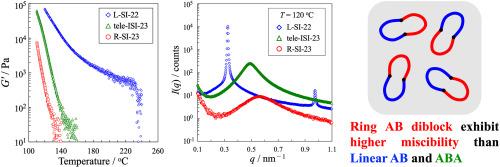基于SAXS和流变学的拓扑约束对对称环双嵌段共聚物熔体混相增强的研究
IF 4.5
2区 化学
Q2 POLYMER SCIENCE
引用次数: 0
摘要
采用小角x射线散射(SAXS)和加热流变学测量方法,研究了总分子量为Mn,总分子量为23 kg/mol (R-SI-23)的聚苯乙烯(S)和聚异戊二烯(I)组成的对称环状二嵌段共聚物在熔体中的混溶性,并与相应的线性SI二嵌段(L-SI-22)和ISI三嵌段(tele- SI-23)进行了比较。从SAXS测量中,L-SI-22呈现出均匀有序的尖峰,证实了层状微相分离结构或在相对较低的120℃下处于有序状态,而R-SI-23和tele- si -23均呈现出宽相关空穴峰,表明它们处于无序状态。动态粘弹性测量还表明,L-SI-22在260℃左右表现出有序-无序转变(ODT),而R-SI-23和tele- si -23即使在120℃左右的低温下也表现出无序状态行为。基于随机相位近似(RPA)理论,以链连接方式为重点,分析了具有宽相关空穴峰的R-SI-23和tele- si -23的散射函数。分析结果表明,R-SI-23的有效Flory-Huggins相互作用参数(χeff)低于tele- si -23。这一结果可能归因于环状聚合物熔体中的拓扑约束,这迫使环状分子中的S和I组分片段靠得更近,从而增强了混相性。本文章由计算机程序翻译,如有差异,请以英文原文为准。


Miscibility enhancement in a symmetric ring diblock copolymer melt due to topological constraint studied by SAXS and rheology
Miscibility between components for a compositionally symmetric ring diblock copolymer consisting of polystyrene (S) and polyisoprene (I) with a total molecular weight of Mn,total = 23 kg/mol (R-SI-23) in melt was investigated by small-angle X-ray scattering (SAXS) and rheological measurements under heating in comparison with the corresponding linear SI diblock (L-SI-22) and ISI triblock (tele-ISI-23). From SAXS measurements, L-SI-22 exhibits even-order sharp peaks, confirming a lamellar microphase-separated structure or it is in an ordered state at a relatively low temperature of 120 °C, while both R-SI-23 and tele-ISI-23 exhibit a broad correlation hole peak each, suggesting that they are in a disordered state. Dynamic viscoelasticity measurements also revealed that L-SI-22 exhibits an order-disorder transition (ODT) at around 260 °C, while R-SI-23 and tele-ISI-23 show disordered-state behavior even at low temperatures around 120 °C. SAXS profiles of R-SI-23 and tele-ISI-23 with a broad correlation hole peak are analyzed for scattering functions based on the random phase approximation (RPA) theory focusing on the chain connecting manners. The analytical results suggest that R-SI-23 has a lower effective Flory-Huggins interaction parameter, χeff, than tele-ISI-23. This result could be attributed to the topological constraints in ring polymer melts, which forces the segments of S and I components in a ring molecule to bring closer together, resulting in enhancing miscibility.
求助全文
通过发布文献求助,成功后即可免费获取论文全文。
去求助
来源期刊

Polymer
化学-高分子科学
CiteScore
7.90
自引率
8.70%
发文量
959
审稿时长
32 days
期刊介绍:
Polymer is an interdisciplinary journal dedicated to publishing innovative and significant advances in Polymer Physics, Chemistry and Technology. We welcome submissions on polymer hybrids, nanocomposites, characterisation and self-assembly. Polymer also publishes work on the technological application of polymers in energy and optoelectronics.
The main scope is covered but not limited to the following core areas:
Polymer Materials
Nanocomposites and hybrid nanomaterials
Polymer blends, films, fibres, networks and porous materials
Physical Characterization
Characterisation, modelling and simulation* of molecular and materials properties in bulk, solution, and thin films
Polymer Engineering
Advanced multiscale processing methods
Polymer Synthesis, Modification and Self-assembly
Including designer polymer architectures, mechanisms and kinetics, and supramolecular polymerization
Technological Applications
Polymers for energy generation and storage
Polymer membranes for separation technology
Polymers for opto- and microelectronics.
 求助内容:
求助内容: 应助结果提醒方式:
应助结果提醒方式:


